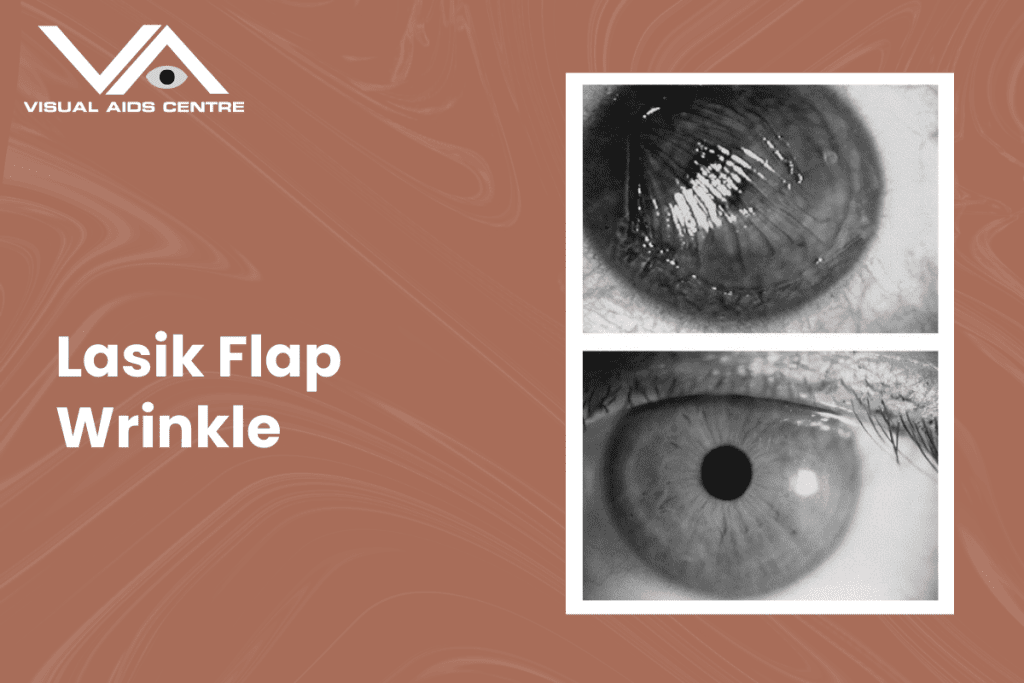Table of Contents
ToggleFor both eye care professionals and patients, the decision to undergo LASIK surgery is not taken lightly. It promises the dream of improved vision and is the fruition of advanced medical technology. However, like any surgical procedure, it is not without potential complications, one of which is the development of LASIK flap wrinkles—also known as striae. These microscopic folds in the corneal flap can arise during or after surgery and, though rare, they can affect visual acuity.
This blog aims to provide a comprehensive overview of LASIK flap wrinkles, including their causes, how to identify them, management strategies, and preventative measures. Whether you’re a seasoned practitioner or a patient considering or recovering from LASIK surgery, understanding this complication is crucial for optimal outcomes.

What are LASIK Flap Wrinkles?
LASIK flap wrinkles (striae) are small folds or creases that can occur in the corneal flap, which is created during the LASIK eye surgery process.
During the procedure, a thin flap is created on the cornea’s surface, which is then lifted to allow laser reshaping of the underlying tissue. Once the corneal reshaping is complete for vision correction, the flap is carefully repositioned but if it doesn’t adhere smoothly or is disturbed during healing, wrinkles can form.
These wrinkles can be microscopic or large enough to affect the patient’s postoperative vision, depending on their severity and location. They are best identified under slit-lamp examination, where careful inspection by an eye care professional can reveal even the most subtle irregularities.
Causes of LASIK Flap Wrinkles
Several factors contribute to the formation of these wrinkles:
- Intraoperative Factors: Excessive manipulation or imperfect flap repositioning during surgery.
- Uneven tear film distribution: An irregular tear film can cause differential surface tension, encouraging the formation of flap wrinkles.
- Inadequate flap adhesion: If the corneal flap does not adhere properly to the underlying stromal bed, it can lead to the formation of wrinkles.
- Early Postoperative Factors: The corneal flap is most fragile in the initial days post-surgery as it heals and reattaches to the stroma below.
Eye-rubbing, trauma, external pressure on the eye, aggressive blinking shortly after surgery or an uneven healing response can disrupt the corneal flap’s adherence to the underlying tissue.
- Individual Healing Patterns: The patient’s corneal healing process can vary, potentially leading to striae. Factors like swelling or edema may contribute to the displacement and wrinkling of the flap.
- Corneal Abnormalities: People with specific corneal irregularities or thin corneas may face an increased risk of flap wrinkles.
Identifying LASIK Flap Wrinkles
Patients may either show no symptoms or exhibit symptoms like:
- Blurred or distorted vision
- Sudden, severe pain in the eye
- Difficulty with night vision or seeing halos, glares or starbursts
- Shadowed vision, particularly if the wrinkle is central and affects the line of sight
- A sensation of eye irritation or discomfort
- Sensitivity to light
- Excessive tearing
Eye care providers can diagnose these wrinkles during a postoperative examination using slit-lamp biomicroscopy, which provides a magnified three-dimensional view of the eye structures. They can identify the presence and extent of the striae on the corneal flap.
Managing LASIK Flap Wrinkles
Treatment of LASIK flap wrinkles typically depends on the severity, location of the wrinkles, and patient symptoms:
- Observation: Minor wrinkles that do not affect the patient’s vision is often left alone and may resolve spontaneously as the healing process continues along with routine follow-ups.
- Flap Smoothing: For wrinkles affecting vision, the flap may need to be lifted and smoothed out. This is often performed under topical anaesthesia. During this process, the surgeon carefully lifts the flap and irons out any wrinkles. Sometimes, an irrigating solution is used to aid in the process.
They ensure proper positioning and allow natural adhesion processes to seal the flap back in place. Depending on wrinkle severity, sutures or specialized solutions may be used to secure the flap to the underlying stroma.
This procedure requires precision and should be undertaken promptly upon identification of the issue.
- Flap Stretches and Massages: Some clinicians utilize techniques such as flap stretching or massaging to reposition the flap and alleviate minor wrinkles non-invasively.
- Contact Lenses: In some cases, a bandage contact lens may be used to apply pressure on the flap, encouraging it to adhere smoothly in place.
- Surgical Intervention: In rare cases where non-invasive techniques are ineffective, surgical intervention may be necessary to correct the wrinkles.
Preventative Measures
Prevention is key, and the following measures can reduce the risk of LASIK flap wrinkles:
- Precise surgical technique and use of up-to-date technology during LASIK surgery.
- Advising patients to:
- Avoid rubbing their eyes or pressing on the eye
- Avoid engaging in activities that may impact the eye during the initial postoperative period
- Using protective eyewear to guard against accidental trauma
- Implementing an appropriate follow-up schedule and examinations to monitor healing progress closely.
The Takeaway: Knowledge is Power for a Smooth LASIK Recovery
While LASIK flap wrinkles are a potential complication of the LASIK procedure, with prompt diagnosis and appropriate treatment, patients can typically continue to enjoy the benefits of improved vision. Eye care professionals play a crucial role in managing and educating patients on how to care for their eyes post-LASIK to prevent such complications.
Remember that patient education pre- and post-surgery is crucial in ensuring optimal outcomes. For those who have undergone LASIK surgery, being mindful of the signs and adhering to follow-up care is an integral part of sustaining the health of your eyes.
Should you experience any visual anomalies or suspect you might have flap wrinkles, consult your eye care provider at the earliest opportunity to discuss the best course of action. By maintaining open communication with your surgeon, you can attain the peace of mind and clearer vision that LASIK surgery promises.













